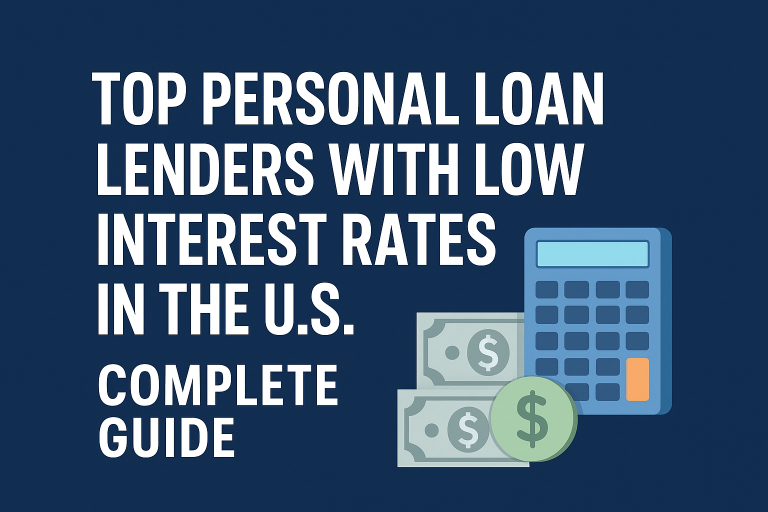inding the right personal loan can save you thousands of dollars over time, especially when it comes to interest rates. In 2025, many lenders in the U.S. are offering competitive APRs, making personal loans an attractive alternative to credit cards and payday loans. This guide highlights the best lenders with low interest rates, what to consider before applying, and tips to qualify for the most affordable financing.
Why Interest Rates Matter When Choosing a Personal Loan
Interest rates, expressed as Annual Percentage Rates (APRs), determine how much you’ll ultimately pay for borrowing money. A small difference in rates can significantly impact total repayment.
For example, a $15,000 loan with a 9% APR over 5 years costs about $3,680 in interest, while the same loan at 15% APR costs over $6,400. That’s nearly double in extra fees.
Low interest rates:
- Reduce monthly payments
- Make debt repayment easier
- Improve affordability for long-term loans
This is why choosing the right lender with competitive APRs is crucial.
How Lenders Determine Your Loan Rate
Not all borrowers qualify for the lowest advertised rates. Lenders consider multiple factors:
- Credit Score: Borrowers with scores above 720 usually qualify for the best rates.
- Income Level: Higher and stable income reduces risk for lenders.
- Debt-to-Income Ratio (DTI): Ideally below 36% for favorable rates.
- Loan Term: Shorter terms usually come with lower APRs.
- Loan Purpose: Consolidation or home improvement loans may have better rates.
Understanding these factors can help you prepare your application to secure the best deal.
Best Personal Loan Providers with Low APR in 2025
Here are the top U.S. lenders known for offering low interest personal loans:
- LightStream (Truist Bank)
- APR: Starting at 7.99% (with AutoPay)
- Loan Amounts: $5,000 – $100,000
- Key Feature: No fees, quick approval
- SoFi
- APR: From 8.99%
- Loan Amounts: $5,000 – $100,000
- Key Feature: Unemployment protection and member perks
- Marcus by Goldman Sachs
- APR: From 9.99%
- Loan Amounts: $3,500 – $40,000
- Key Feature: No origination fees or prepayment penalties
- Discover Personal Loans
- APR: Starting at 9.99%
- Loan Amounts: $2,500 – $40,000
- Key Feature: Flexible repayment up to 7 years
- Wells Fargo Personal Loans
- APR: From 9.49%
- Loan Amounts: $3,000 – $100,000
- Key Feature: Established bank with nationwide branches
How to Qualify for the Lowest Personal Loan Rates
Even if you don’t have perfect credit, you can take steps to increase your chances of securing a lower APR:
- Improve Your Credit Score: Pay bills on time, reduce credit utilization.
- Apply with a Co-Signer: Lenders may lower rates with added security.
- Choose Shorter Loan Terms: Opting for 24 or 36 months may lower rates.
- Show Proof of Income: Strong income and job stability improve approval odds.
- Compare Pre-Qualification Offers: Many lenders allow soft inquiries to check estimated APRs.
Pros and Cons of Low-Interest Personal Loans
Pros:
- Affordable monthly payments
- Lower overall cost of borrowing
- Flexible loan usage (medical bills, home improvement, debt consolidation)
- Predictable repayment schedule
Cons:
- Requires strong or fair credit for best rates
- May include origination fees
- Longer approval process compared to payday loans
Alternatives to Traditional Low-Rate Loans
If you can’t qualify for a lender’s lowest APR, consider these alternatives:
- Credit Unions: Often offer better rates than traditional banks.
- Peer-to-Peer Lending Platforms: Flexible requirements with competitive APRs.
- Home Equity Loans or HELOCs: Lower rates for homeowners, but require collateral.
- Balance Transfer Credit Cards: 0% APR offers for 12–18 months (for smaller debts).
Final Thoughts
Low-interest personal loans can be a cost-effective borrowing solution in 2025, helping Americans finance major expenses without overwhelming debt. By comparing lenders like LightStream, SoFi, Marcus, and Discover, and taking steps to improve your credit profile, you can unlock the most competitive rates available.
The key is to shop around, pre-qualify when possible, and choose a loan structure that aligns with your financial goals.
